Ultrasonic-Assisted Brazing of Titanium Joints Using Modified Al-Si-Cu Based Fillers: Brazing at Liquid—Semisolid States under Load
Abstract
:1. Introduction
2. Materials and Methods
2.1. Preparation of Bulk Filler Alloys
2.2. Preparation of the Brazing Assembly
2.3. Fillers and Joints Characterization
2.4. Experimental Set-Up
2.5. Cooling Curves and Solid Fraction Calculation
2.6. Brazing Methods and Conditions
3. Results and Discussion
3.1. Results by Using Brazing Cycle A
3.2. Results by Using Brazing Cycle B
3.3. The Effect of the Second Load and Filler Composition on the Mechanical Properties
4. Conclusions
Author Contributions
Funding
Conflicts of Interest
References
- Muhrat, A.; Barbosa, J. Ultrasonic-Assisted Brazing of Titanium Joints Using Al-Si Based Fillers: Numerical and Experimental Process Design. Metals 2021, 11, 1686. [Google Scholar] [CrossRef]
- Shapiro, A.E.; Flom, Y.A. Brazing of Titanium at Temperatures below 800 °C: Review and Prospective Applications. DVS Ber. 2007, 243, 254. [Google Scholar]
- Chen, X.; Yan, J.; Gao, F.; Wei, J.; Xu, Z.; Fan, G. Interaction Behaviors at the Interface between Liquid Al-Si and Solid Ti–6Al–4V in Ultrasonic-Assisted Brazing in Air. Ultrason. Sonochem. 2013, 20, 144–154. [Google Scholar] [CrossRef]
- Chen, X.; Xie, R.; Lai, Z.; Liu, L.; Zou, G.; Yan, J. Ultrasonic-Assisted Brazing of Al–Ti Dissimilar Alloy by a Filler Metal with a Large Semi-Solid Temperature Range. Mater. Des. 2016, 95, 296–305. [Google Scholar] [CrossRef]
- Chen, X.; Yan, J.; Ren, S.; Wei, J.; Wang, Q. Microstructure and Mechanical Properties of Ti–6Al–4V/Al1060 Joints by Ultrasonic-Assisted Brazing in Air. Mater. Lett. 2013, 95, 197–200. [Google Scholar] [CrossRef]
- Li, Z.; Xu, Z.; Ma, L.; Wang, S.; Liu, X.; Yan, J. Cavitation at Filler Metal/Substrate Interface during Ultrasonic-Assisted Soldering. Part I: Cavitation Characteristics. Ultrason. Sonochem. 2018, 49, 249–259. [Google Scholar] [CrossRef]
- Elrefaey, A.; Wojarski, L.; Pfeiffer, J.; Tillmann, W. Preliminary Investigation on Ultrasonic-Assisted Brazing of Titanium and Titanium/Stainless Steel Joints. Weld. J. 2013, 92, 148–153. [Google Scholar]
- Wang, Q.G.; Caceres, C.H.; Griffiths, J.R. Damage by Eutectic Particle Cracking in Aluminum Casting Alloys A356/357. Met. Mater. Trans. A 2003, 34, 2901–2912. [Google Scholar] [CrossRef]
- Joseph, S.; Kumar, S.; Bhadram, V.S.; Narayana, C. Stress States in Individual Si Particles of a Cast Al–Si Alloy: Micro-Raman Analysis and Microstructure Based Modeling. J. Alloys Compd. 2015, 625, 296–308. [Google Scholar] [CrossRef]
- Timpel, M.; Wanderka, N.; Schlesiger, R.; Yamamoto, T.; Lazarev, N.; Isheim, D.; Schmitz, G.; Matsumura, S.; Banhart, J. The Role of Strontium in Modifying Aluminium–Silicon Alloys. Acta Mater. 2012, 60, 3920–3928. [Google Scholar] [CrossRef]
- Djurdjevic, M.; Stockwell, T.; Sokolowski, J. The Effect of Strontium on the Microstructure of the Aluminium-Silicon and Aluminium-Copper Eutectics in the 319 Aluminium Alloy. Int. J. Cast Met. Res. 1999, 12, 67–73. [Google Scholar] [CrossRef]
- Mazahery, A.; Shabani, M.O. Modification Mechanism and Microstructural Characteristics of Eutectic Si in Casting Al-Si Alloys: A Review on Experimental and Numerical Studies. JOM 2014, 66, 726–738. [Google Scholar] [CrossRef]
- Omran, A.; Ali, M.; Kh, M.; Ezzeldien, M. Effect of strontium content on the mechanical properties of hypo and hyper al-si cast alloys. J. Al-Azhar Univ. Eng. Sect. 2018, 13, 1322–1331. [Google Scholar] [CrossRef]
- Sun, X.; Wu, W.; Wang, D.; Deng, P. The Influence of Sr Addition on the Microstructure and Mechanical Properties of Aluminum Die-Casting Alloys. MATEC Web Conf. 2016, 67, 05027. [Google Scholar] [CrossRef] [Green Version]
- Qingjie, W.; Hong, Y.; Yuan, L.; Zhi, H. Effect of Sr Modification on Microstructures and Mechanical Properties of Al3Ti/ADC12 Composites. Rare Met. Mater. Eng. 2018, 47, 742–747. [Google Scholar] [CrossRef]
- Yang, Y.; Yu, K.; Li, Y.; Zhao, D.; Liu, X. Evolution of Nickel-Rich Phases in Al–Si–Cu–Ni–Mg Piston Alloys with Different Cu Additions. Mater. Des. 2012, 33, 220–225. [Google Scholar] [CrossRef]
- Muhrat, A.; Puga, H.; Barbosa, J. Low-Temperature Brazing of Titanium Using Al-Based Filler Alloys. Adv. Mater. Sci. Eng. 2018, 2018, 4570120. [Google Scholar] [CrossRef] [Green Version]
- Školáková, A.; Novák, P.; Mejzlíková, L.; Průša, F.; Salvetr, P.; Vojtěch, D. Structure and Mechanical Properties of Al-Cu-Fe-X Alloys with Excellent Thermal Stability. Materials 2017, 10, 1269. [Google Scholar] [CrossRef] [PubMed] [Green Version]
- Koç, F.G.; Karakulak, E.; Yamanoğlu, R.; Zeren, M. Mechanical properties of al-ni cast alloys. Mater. Test. 2014, 7, 1283–1287. [Google Scholar]
- Samuel, A.M.; Samuel, F.H. Effect of Melt Treatment, Solidification Conditions and Porosity Level on the Tensile Properties of 319.2 Endchill Aluminium Castings. J. Mater. Sci. 1995, 30, 4823–4833. [Google Scholar] [CrossRef]
- Cáceres, C.H.; Djurdjevic, M.B.; Stockwell, T.J.; Sokolowski, J.H. The Effect of Cu Content on the Level of Microporosity in Al-Si-Cu-Mg Casting Alloys. Scr. Mater. 1999, 40, 631–637. [Google Scholar] [CrossRef]
- Eskin, G.I.; Eskin, D.G. Ultrasonic Treatment of Light Alloy Melts; CRC Press: Boca Raton, FL, USA, 2014. [Google Scholar]
- Shabestari, S. The Effect of Iron and Manganese on the Formation of Intermetallic Compounds in Aluminum–Silicon Alloys. Mater. Sci. Eng. A 2004, 383, 289–298. [Google Scholar] [CrossRef]
- Pehlke, R.D. Formation of Porosity During Solidification of Cast Metals. In Foundry Processes; Katz, S., Landefeld, C.F., Eds.; Springer: Boston, MA, USA, 1988; pp. 427–445. ISBN 978-1-4612-8292-1. [Google Scholar]
- Muhrat, A.; Puga, H.; Barbosa, J. Ultrasonic Vibration as a Primary Mixing Tool in Accelerating Aluminum–Copper Alloys Preparation from Their Pure Elements. Metals 2019, 9, 781. [Google Scholar] [CrossRef] [Green Version]
- De Giovanni, M.; Kaduk, J.A.; Srirangam, P. Modification of Al-Si Alloys by Ce or Ce with Sr. JOM 2019, 71, 426–434. [Google Scholar] [CrossRef] [Green Version]
- Farahany, S.; Ourdjini, A.; Bakar, T.A.A.; Idris, M.H. On the Refinement Mechanism of Silicon in Al-Si-Cu-Zn Alloy with Addition of Bismuth. Met. Mater. Trans. A 2014, 45, 1085–1088. [Google Scholar] [CrossRef]
- Djurdjevic, M.; Jiang, H.; Sokolowski, J. On-Line Prediction of Aluminum–Silicon Eutectic Modification Level Using Thermal Analysis. Mater. Charact. 2001, 46, 31–38. [Google Scholar] [CrossRef]
- Farahany, S.; Ourdjini, A.; Idris, M.H. The Usage of Computer-Aided Cooling Curve Thermal Analysis to Optimise Eutectic Refiner and Modifier in Al–Si Alloys. J. Therm. Anal. Calorim. 2012, 109, 105–111. [Google Scholar] [CrossRef]
- Tupaj, M.; Orłowicz, A.W.; Mróz, M.; Trytek, A.; Dolata, A.J.; Dziedzic, A. A Study on Material Properties of Intermetallic Phases in a Multicomponent Hypereutectic Al-Si Alloy with the Use of Nanoindentation Testing. Materials 2020, 13, 5612. [Google Scholar] [CrossRef] [PubMed]
- Fang, L.; Ren, L.; Geng, X.; Hu, H.; Nie, X.; Tjong, J. Solidification and Microstructure of Ni-Containing Al-Si-Cu Alloy. IOP Conf. Ser. Mater. Sci. Eng. 2018, 301, 012002. [Google Scholar] [CrossRef]
- Taylor, J.A. The Effect of Iron in Al-Si Casting Alloys. In Proceedings of the 35th Australian Foundry Institute National Conference, Adeiaide, SA, Australia, 31 October–3 November 2004. [Google Scholar]
- Dinnis, C.M.; Taylor, J.A.; Dahle, A.K. Porosity formation and eutectic growth in Al-Si-Cu-Mg alloys containing Iron and Manganese. In Proceedings of the Proceedings of the 9th International Conference on Aluminium Alloys (ICAA9), Brisbane, Australia, 2–5 August 2004; pp. 1016–1021. [Google Scholar]
- Taylor, J.A.; Schaffer, G.B.; StJohn, D.H. The Role of Iron in the Formation of Porosity in Al-Si-Cu-Based Casting Alloys: Part III. A Microstructural Model. Met. Mater. Trans. A 1999, 30, 1657–1662. [Google Scholar] [CrossRef]
- Taylor, J.A. Iron-Containing Intermetallic Phases in Al-Si Based Casting Alloys. Procedia Mater. Sci. 2012, 1, 19–33. [Google Scholar] [CrossRef] [Green Version]
- Feng, Y.; Založnik, M.; Thomas, B.; Phillion, A. A 3D Discrete-Element Model for Simulating Liquid Feeding during Dendritic Solidification of Steel. IOP Conf. Ser. Mater. Sci. Eng. 2019, 529, 012031. [Google Scholar] [CrossRef]
- Pola, A.; Tocci, M.; Kapranos, P. Microstructure and Properties of Semi-Solid Aluminum Alloys: A Literature Review. Metals 2018, 8, 181. [Google Scholar] [CrossRef] [Green Version]
- Perez, M.; Barbé, J.-C.; Neda, Z.; Bréchet, Y.; Salvo, L. Computer Simulation of the Microstructure and Rheology of Semi-Solid Alloys under Shear. Acta Mater. 2000, 48, 3773–3782. [Google Scholar] [CrossRef] [Green Version]
- Shi, L.; Yan, J.; Peng, B.; Han, Y. Deformation Behavior of Semi-Solid Zn–Al Alloy Filler Metal during Compression. Mate. Sci. Eng. A 2011, 528, 7084–7092. [Google Scholar] [CrossRef]
- Xiao, J.; Li, S.; Bai, S.; Xiong, D.; Tang, Y. Semisolid Compression Brazing of Al50Si Alloy Using Zn-Al-Cu Filler Metal Assisted by SiC Particles. Adv. Mater. Sci. Eng. 2019, 2019, 3275810. [Google Scholar] [CrossRef] [Green Version]
- Yu, X.; Xing, W.; Ding, M. Ultrasonic Semi-Solid Coating Soldering 6061 Aluminum Alloys with Sn–Pb–Zn Alloys. Ultrason. Sonochem. 2016, 31, 216–221. [Google Scholar] [CrossRef]
- Emadi, D.; Whiting, L.V.; Djurdjevic, M.; Kierkus, W.T.; Sokolowski, J. Comparison of Newtonian and Fourier Thermal Analysis Techniques for Calculation of Latent Heat and Solid Fraction of Aluminum Alloys. MJoM 2004, 10, 91–106. [Google Scholar] [CrossRef] [Green Version]
- Marchwica, P.; Sokolowski, J.H.; Kierkus, W.T. Fraction Solid Evolution Characteristics of AlSiCu Alloys—Dynamic Baseline Approach. J. Achiev. Mater. Manuf. Eng. 2011, 47, 22. [Google Scholar]
- Upadhya, K.G.; Stefanescu, D.M.; Lieu, K.; Yeager, D.P. Computer-Aided Cooling Curve Analysis: Principles and Applications in Metal Casting. In Transactions American Foundrymen’s Soc; American Foundry Society: Schaumburg, IL, USA, 1989; Volume 97, pp. 61–66. [Google Scholar]
- Fras, E.; Kapturkiewicz, W.; Burbielko, A.; Lopez, H.F. A New Concept in Thermal Analysis of Castings. 8. AFS Trans. 1993, 101, 505–511. [Google Scholar]
- Chaturvedi, M.C.; Chaturvedi, M.C. (Eds.) Welding and Joining of Aerospace Materials; Woodhead Publishing in Materials; WP, Woodhead Publishing: Oxford, UK, 2012; ISBN 978-0-85709-516-9. [Google Scholar]
- Riggs, B.; Benatar, A.; Alexandrov, B.T.; Xu, R. Experimental Validation of Damage Zone Models for Lap Shear Brazed Joints Using DIC. Weld. J. 2017, 96, 8. [Google Scholar]
- Broughton, W.R.; Hinopoulos, G. Evaluation of the Single-Lap Joint Using Finite Element Analysis. Mater. Sci. 1999. Available online: https://eprintspublications.npl.co.uk/1281/ (accessed on 20 October 2021).
- Flom, Y.; Wang, L. Flaw tolerance in lap shear brazed joints-part 1. Weld. J. 2004, 83, 32–38. [Google Scholar]
- Zhang, C.; Robson, J.D.; Haigh, S.J.; Prangnell, P.B. Interfacial Segregation of Alloying Elements During Dissimilar Ultrasonic Welding of AA6111 Aluminum and Ti6Al4V Titanium. Met. Mater. Trans. A 2019, 50, 5143–5152. [Google Scholar] [CrossRef] [Green Version]
- Takemoto, T.; Okamoto, I. Intermetallic Compounds Formed during Brazing of Titanium with Aluminium Filler Metals. J. Mater. Sci. 1988, 23, 1301–1308. [Google Scholar] [CrossRef]
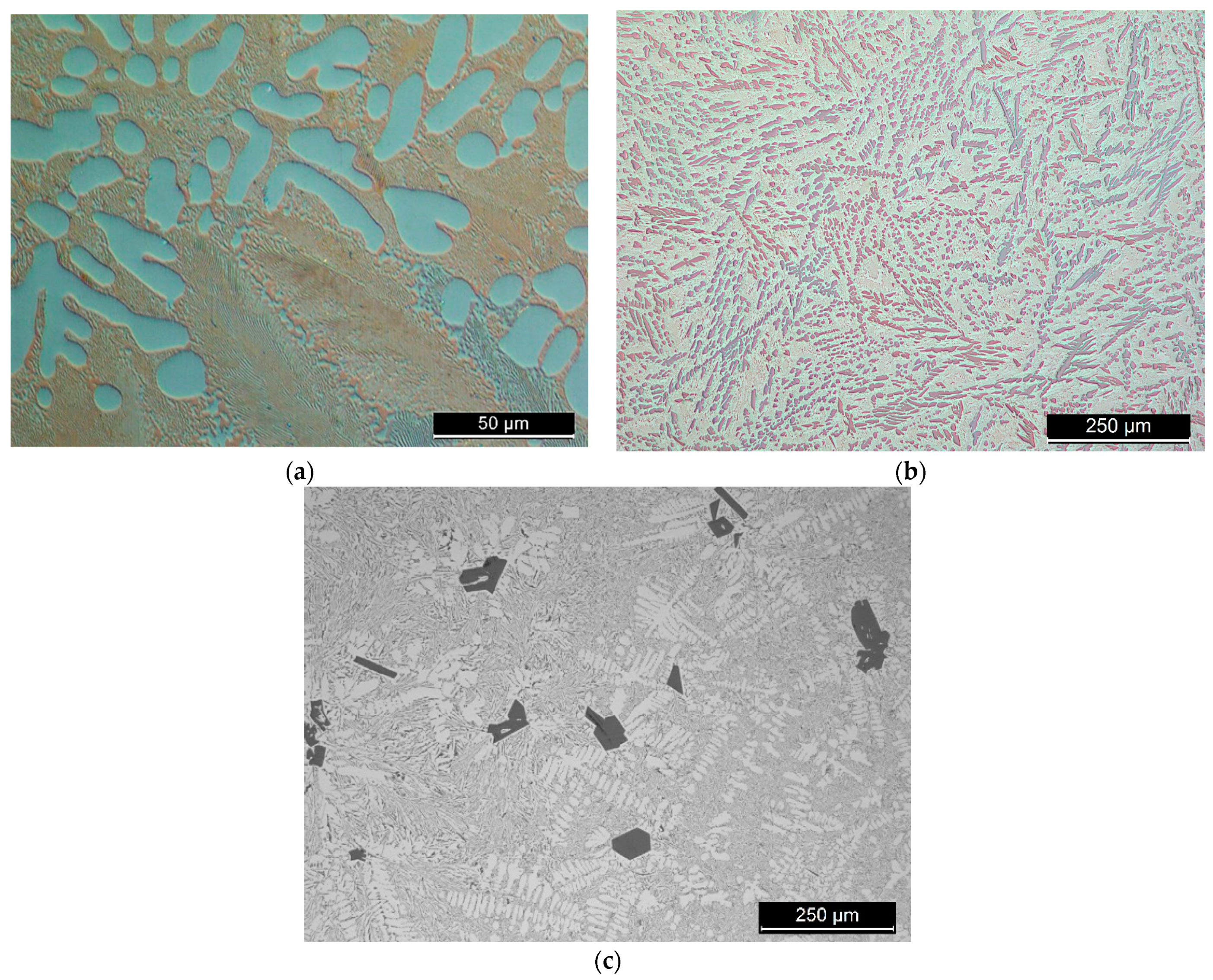
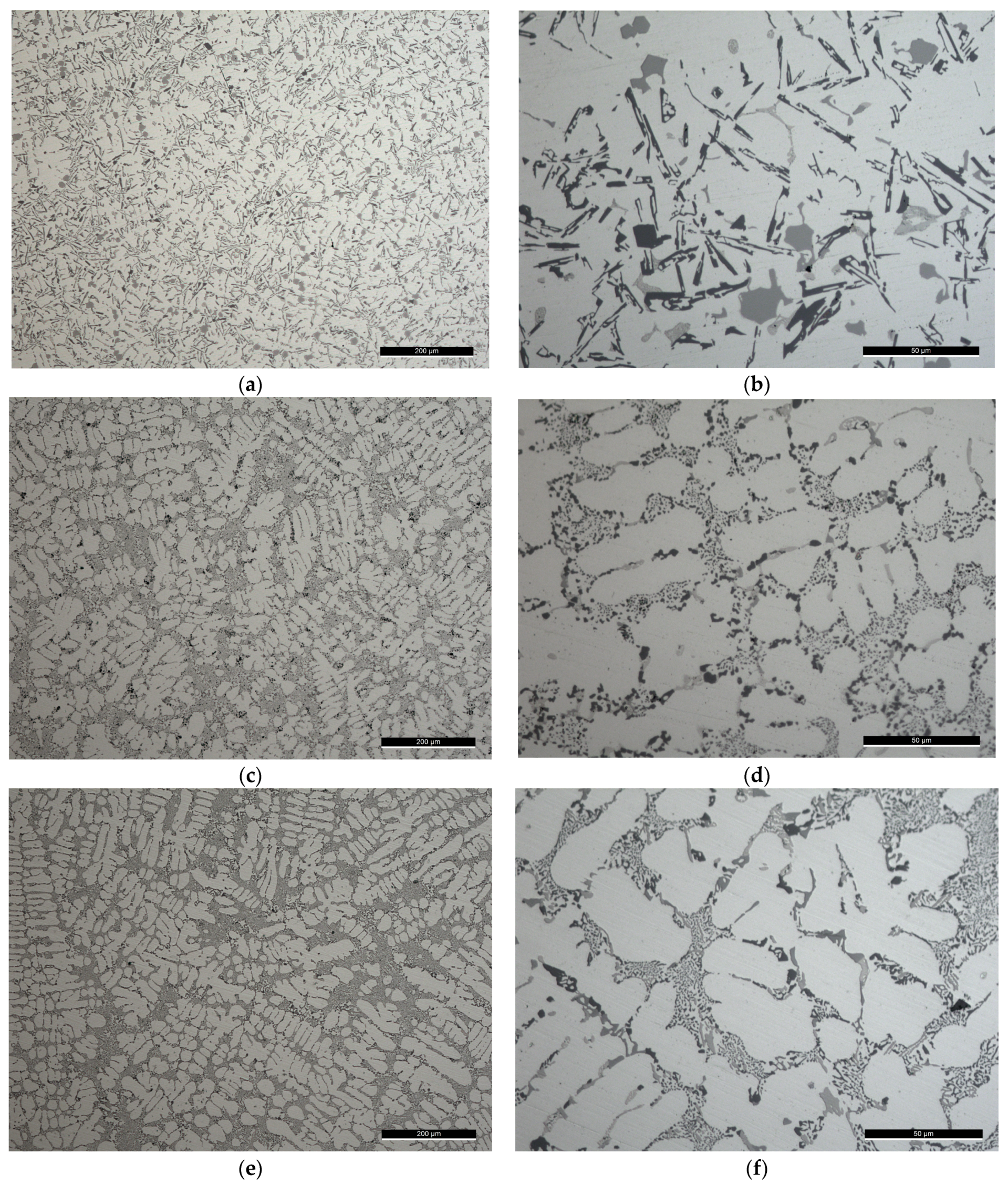
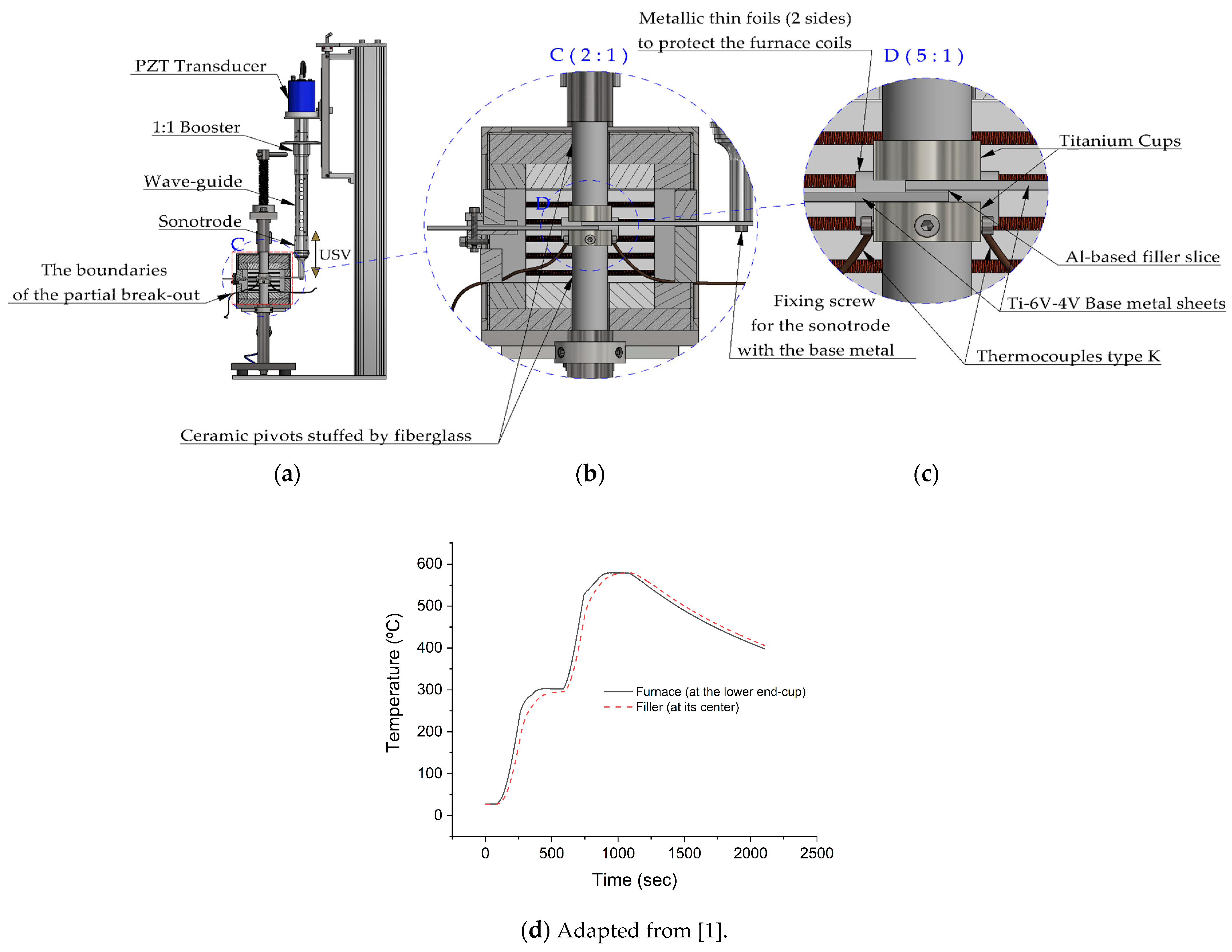
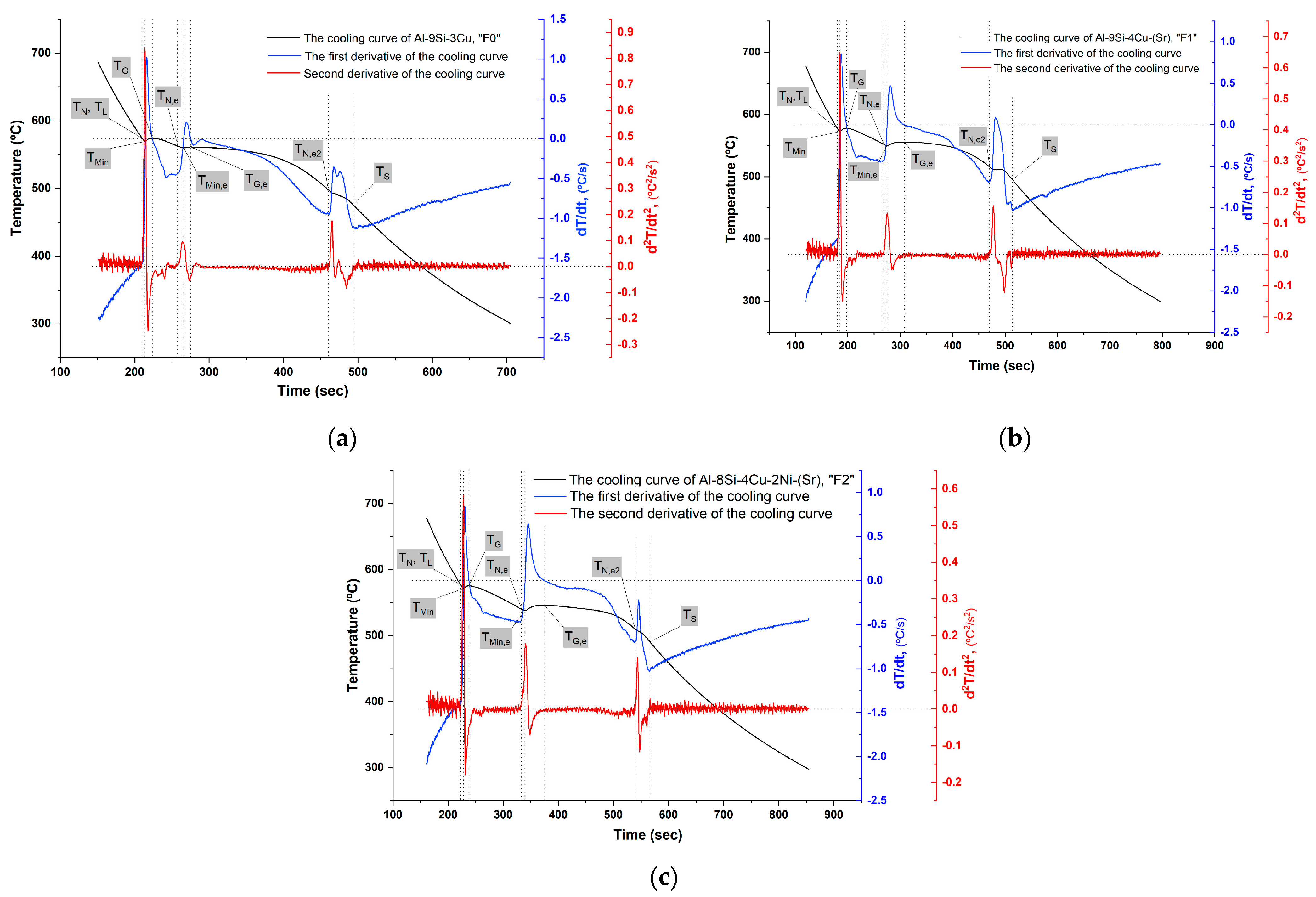
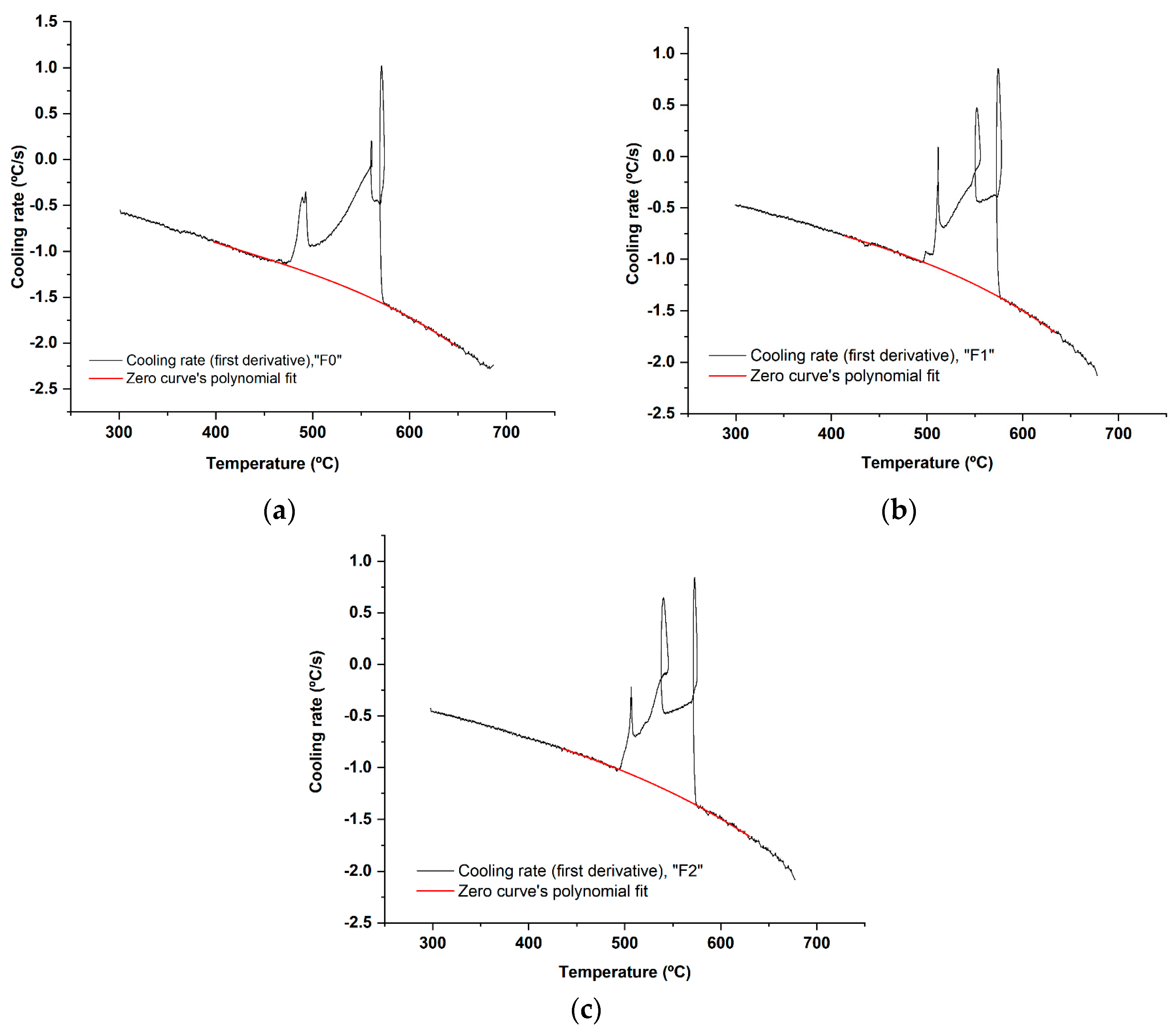
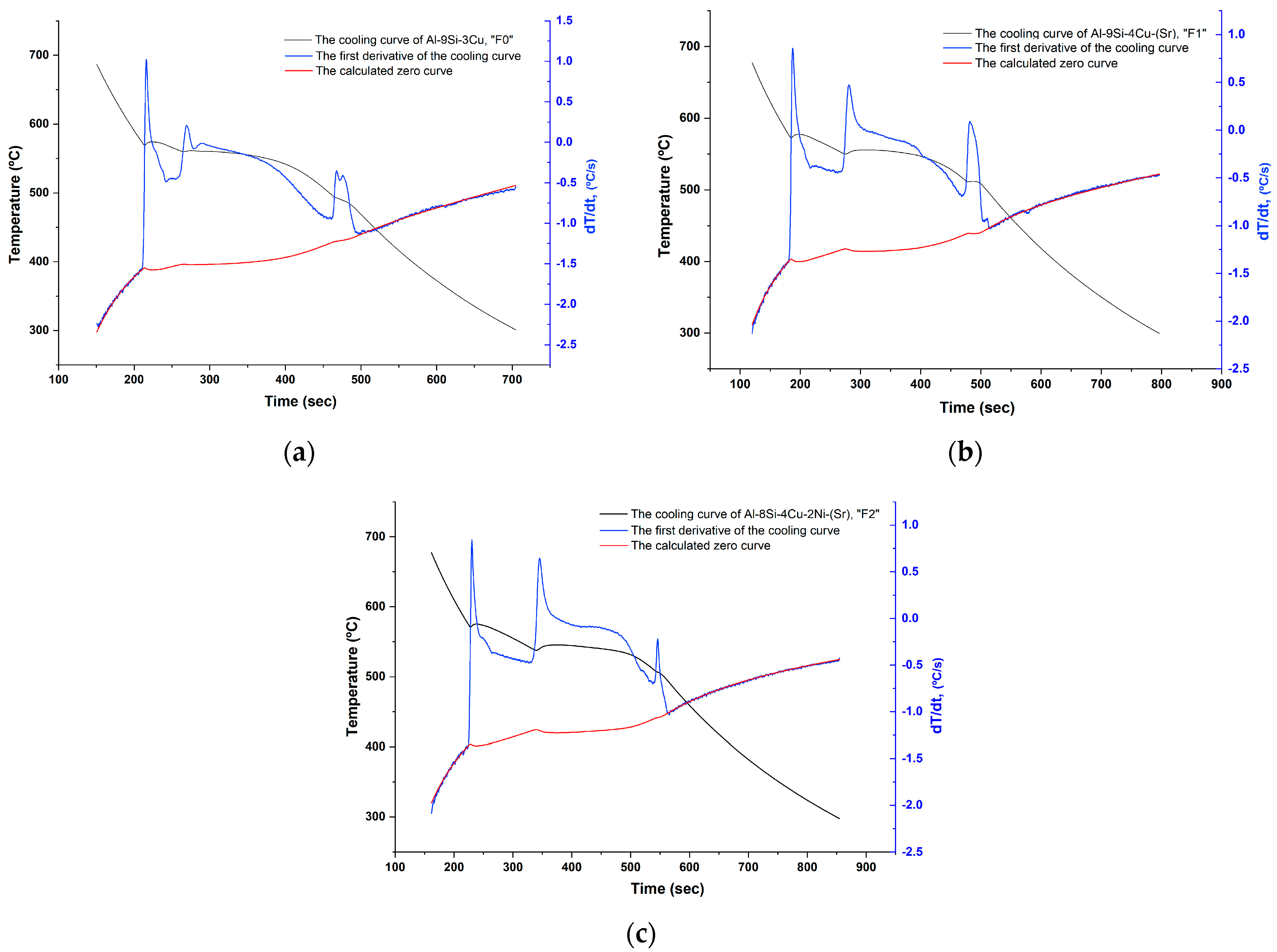


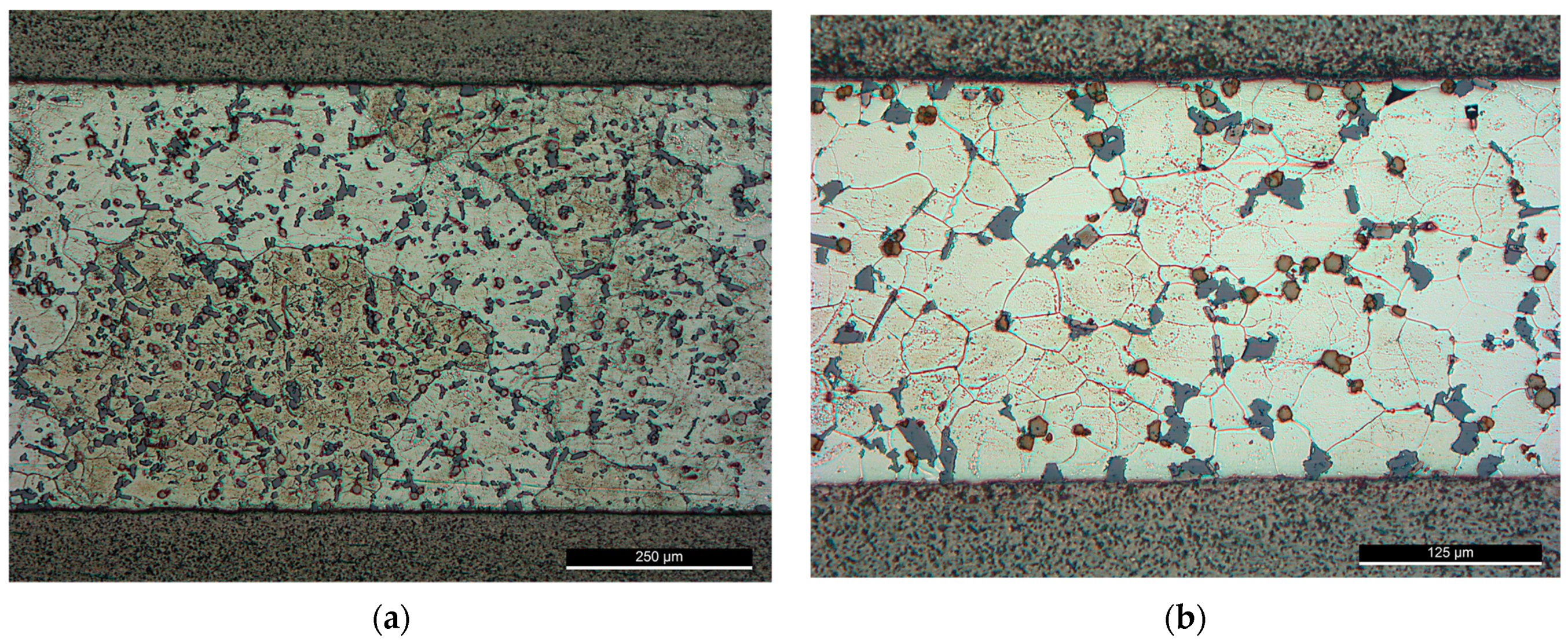


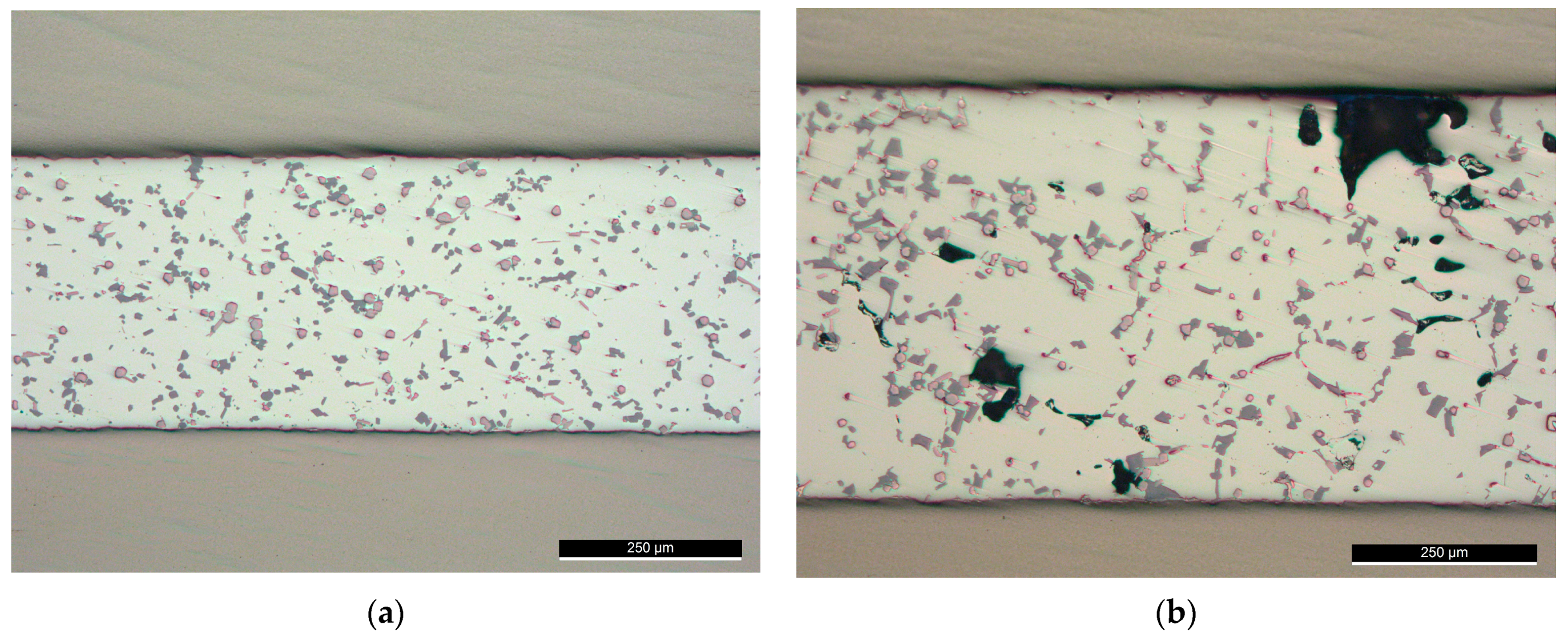

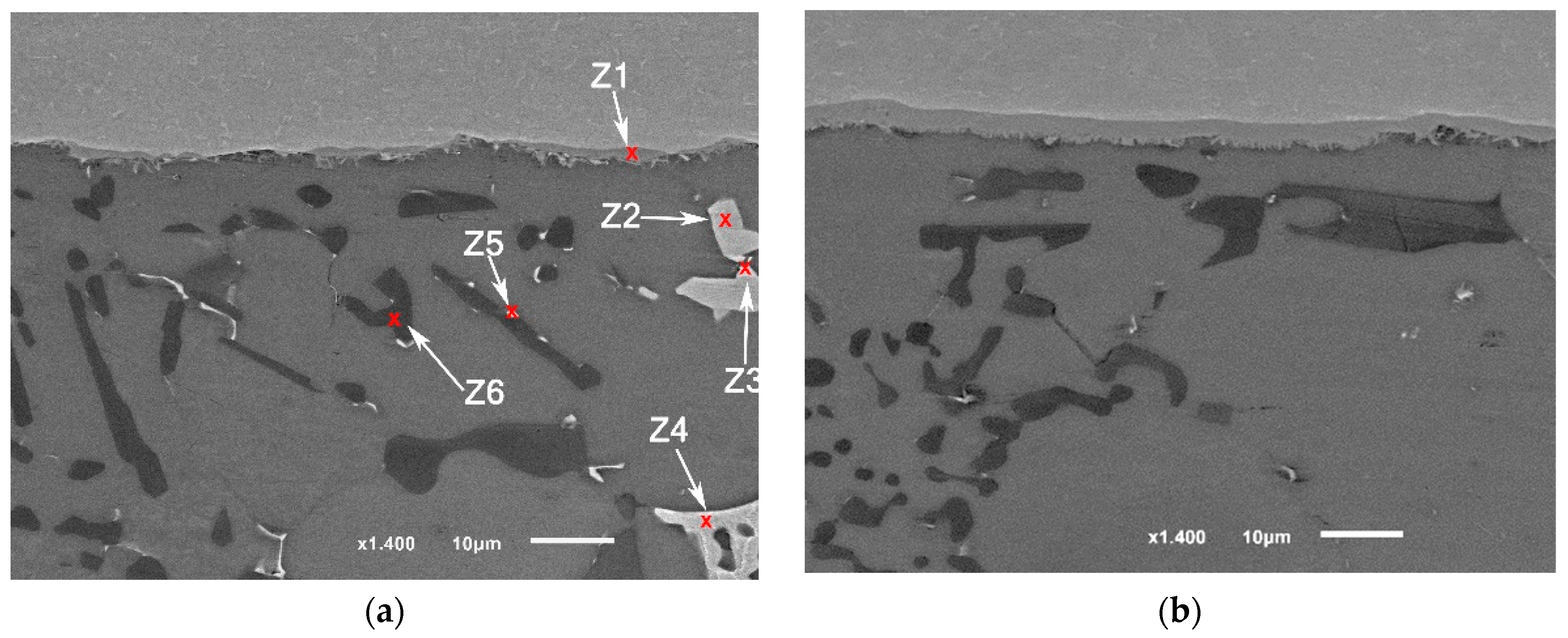

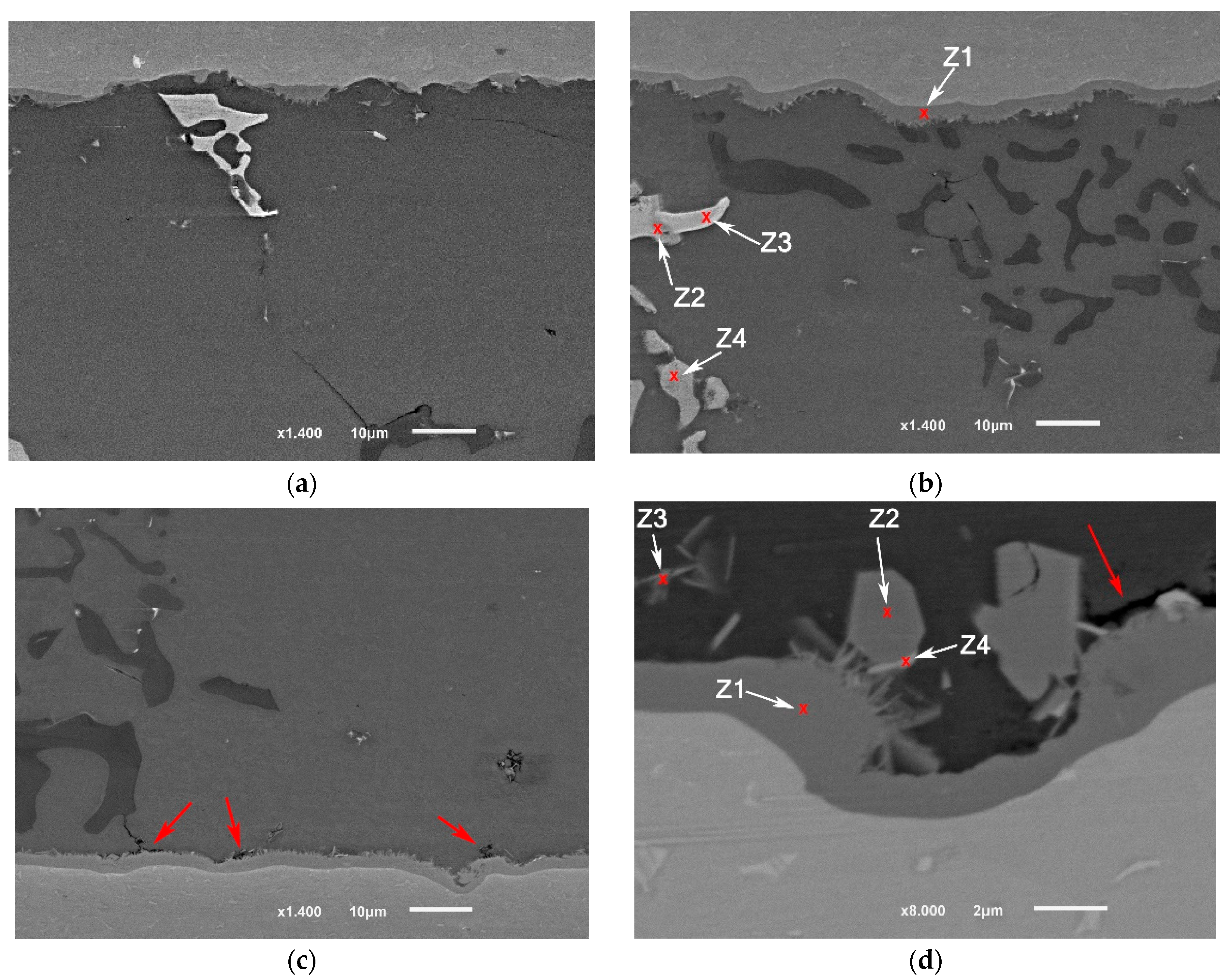

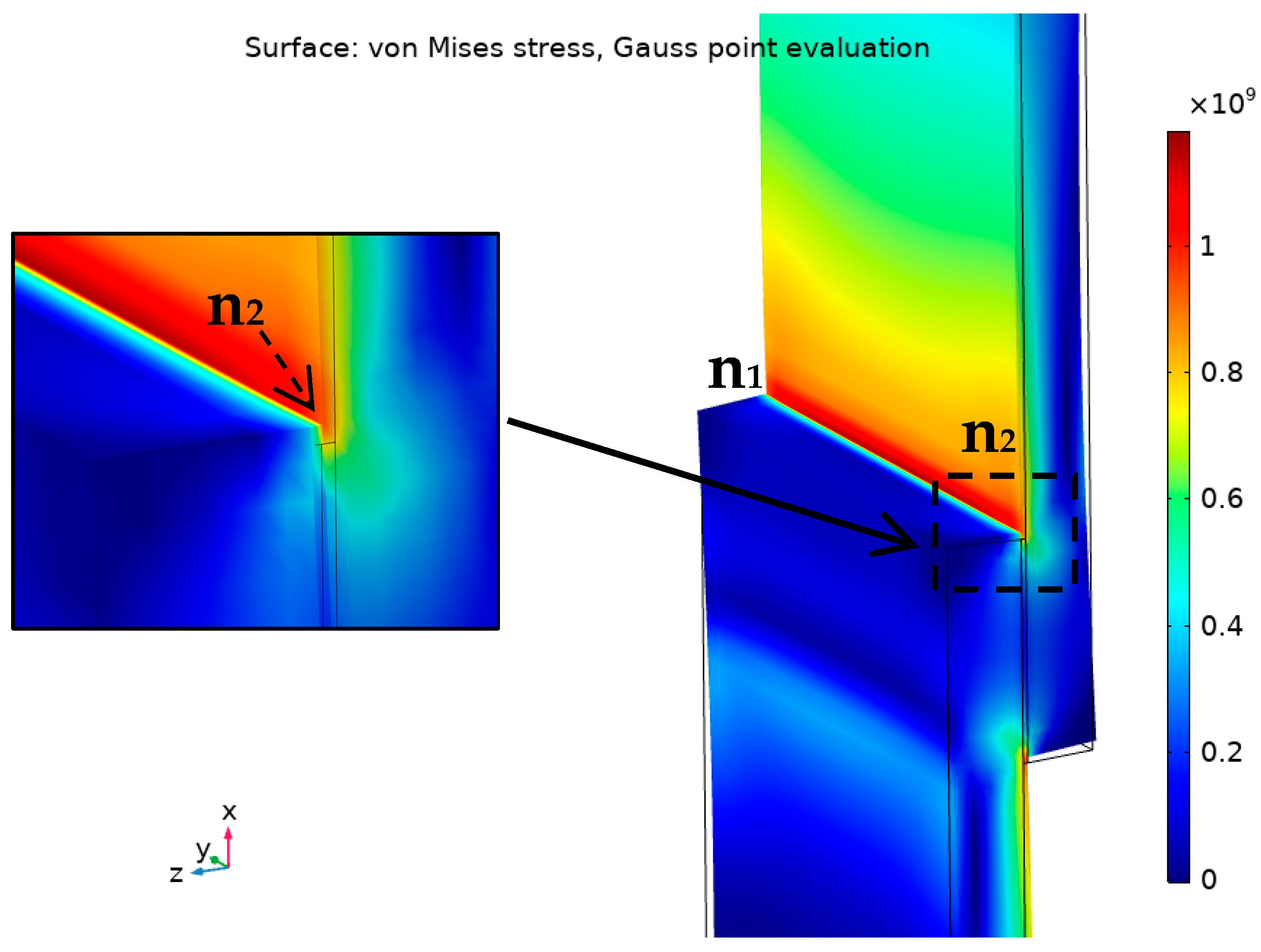

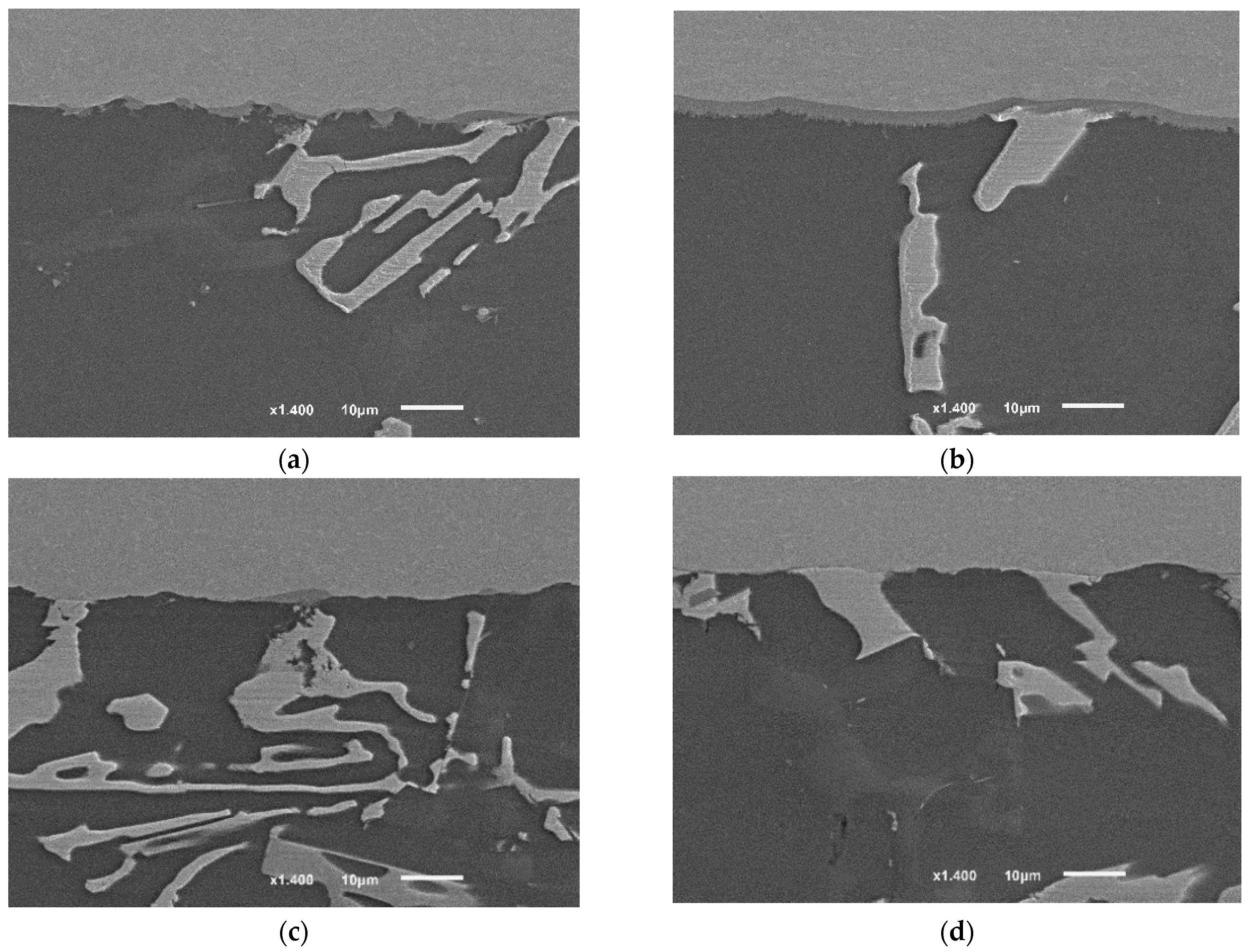


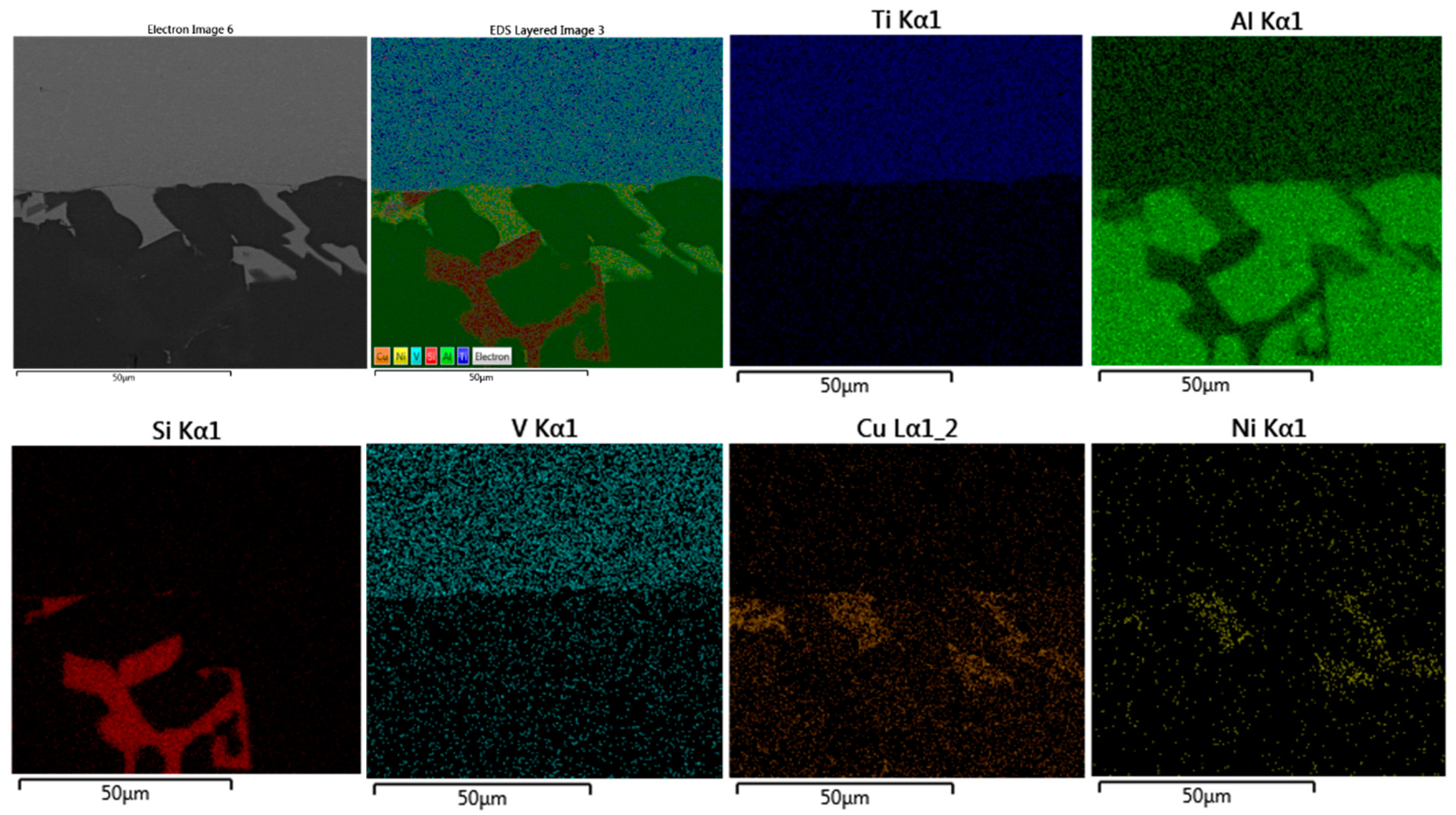
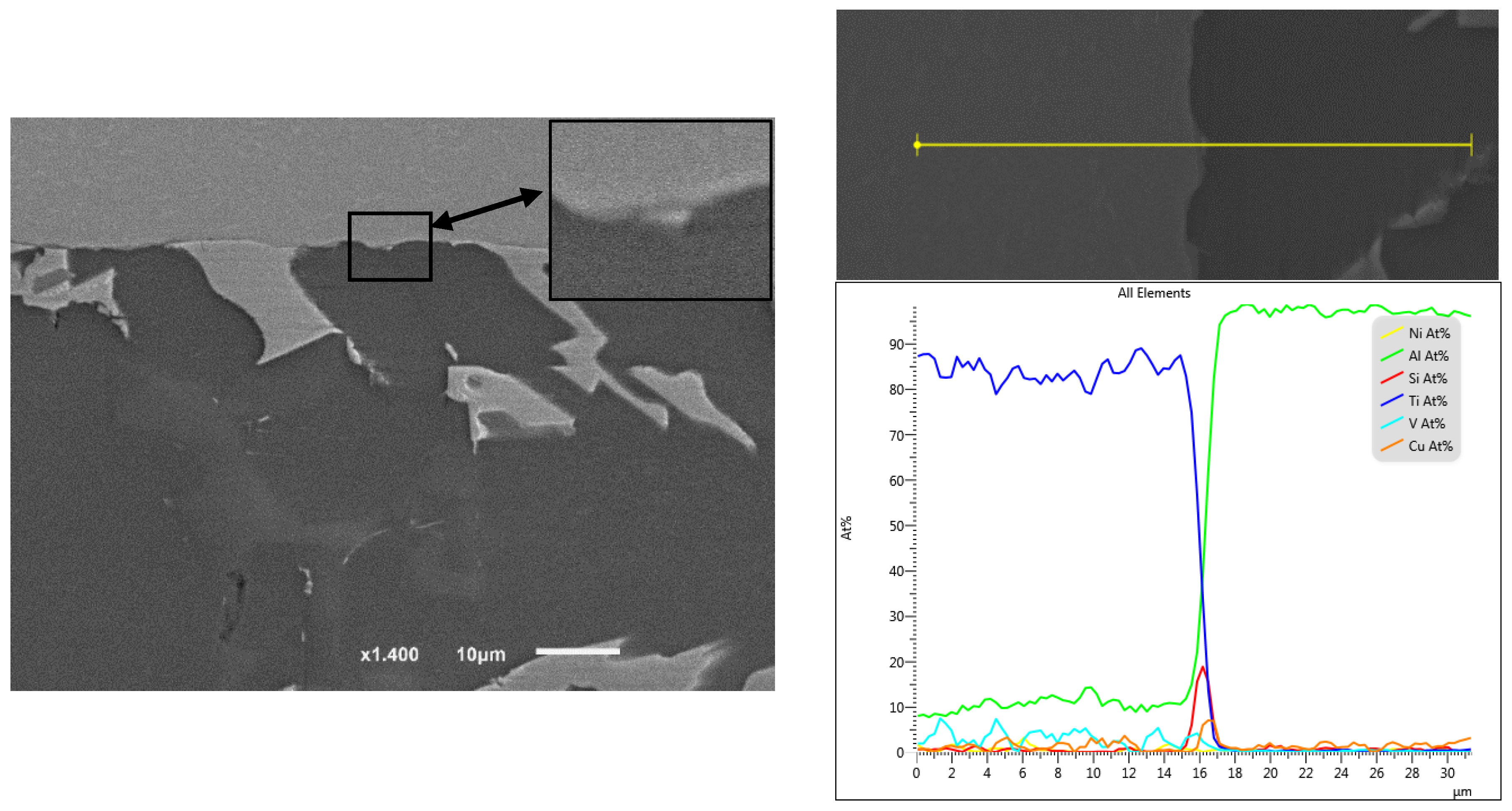
| Master Alloy | Alloy Origin | Treatments | Composition, wt.% | |||||||
|---|---|---|---|---|---|---|---|---|---|---|
| Ni | Si | Cu | Fe | Ti | Sr | Mg | Al | |||
| Al-16Ni | Lab-made | Melted and degassed for 2 times | 16.04 | - | - | - | - | - | - | Bal. |
| Al-27Cu | Lab-made | Melted and degassed for 2 times | - | - | 27.1 | - | - | - | - | Bal. |
| Al-13Si | Commercially available ingot | Melted and degassed | - | 13.12 | 0.022 | 0.47 | 0.012 | - | 0.007 | Bal. |
| Al-5Sr (Nominal composition) | Commercially available rod | Added to the melt directly | - | - | - | - | - | 5 | - | Bal. |
| Filler Code | Filler Alloy | Ni | Si | Cu | Fe | Ti | Sr | Mg | Zn | Mn | Al |
|---|---|---|---|---|---|---|---|---|---|---|---|
| F0 | Al-9Si-3Cu * | 0.097 | 9.183 | 3.178 | 0.891 | 0.029 | - | 0.178 | 0.835 | 0.253 | Bal. |
| F1 | Al-9Si-4Cu-(Sr) | 0.084 | 9.054 | 3.903 | 0.318 | 0.0087 | 0.0193 | - | 0.019 | 0.033 | Bal. |
| F2 | Al-8Si-4Cu-2Ni-(Sr) | 2.345 | 7.905 | 4.078 | 0.302 | 0.0096 | 0.0258 | - | 0.014 | 0.031 | Bal. |
| Stage | Temperture (°C) | |||
|---|---|---|---|---|
| F0 | F1 | F2 | ||
| 1 | ) | =575 =569 = 574 | 577 572 578 | 577 571 575 |
| 2 | ) + Si | =562 =560 = 561 | 552 550 556 | 540 538 545 |
| 3 | Formation of complex intermetallic/eutectics Starting by Al-Cu-(Ni) intermetallic followed by at a lower temperature, ending by Al-Cu-Mg-Si complex intermetallic for F0 | = 498 | 516 | 510 |
| 4 | Non-equilibrium solidus temperature | = 476 | 495 | 491 |
| Brazing Cycle ** | Condition Code (Starting by Filler Type F0, F1, or F2) | Initial Load, kg | Heating to, C/Holding, min | USV Temp., °C | USV Period, sec (Furnace Off) | Pressure, MPa, (Second Load, kg) / Temp.,°C (Furnace Off) | |
|---|---|---|---|---|---|---|---|
| A | F0-1 | 20 | 550/3 | 550 | 10 | )/~549 * | |
| F0-2 | 20 | 565/3 | 565 | 10 | )/~564 * | ||
| F0-3 | 20 | 580/3 | 580 | 10 | )/~569 * | ||
| F0-4 | 20 | 565/3 | 565 | 10 | 6 **)/~564 * | ||
| F0-5 | 20 | 565/3 | 565 | 10 | - | ||
| USV Period, sec (No Heat Provided ***) | Pressure, MPa, (Second Load, kg) /Solid Fraction **** | Holding under Load, min (Holding Time No. 4) | |||||
| B | F1-1 | 20 | 580/3 | 580 | 10 | 8 **)/0.7 | 6 |
| F1-2 | 20 | 580/3 | 580 | 10 | )/0.7 | 12 | |
| F2-1 | 20 | 580/3 | 580 | 10 | )/0.7 | 6 | |
| F2-2 | 20 | 580/3 | 580 | 10 | )/0.7 | 12 | |
| F1-3 | 20 | 580/3 | 580 | 10 | 16 **)/0.7 | 12 | |
| F2-3 | 20 | 580/3 | 580 | 10 | )/0.7 | 12 | |
| F2-4 | 20 | 580/3 | 580 | 10 | 0/0.7 | 12 | |
| Ti | Si | Al | Fe | O | Cu | Mn | Cr | Estimated Phase (s) | |
|---|---|---|---|---|---|---|---|---|---|
| Z1 | 9.6 | 15.8 | 60.8 | 13.4 | 0.5 | ||||
| Z2 | 11.9 | 70.9 | 10.7 | 1.2 | 4.3 | 1.0 | |||
| Z3 | 75.8 | 24.2 | Silicon particles | ||||||
| Z4 | 91.3 | 8.7 | |||||||
| Z5 | 17.2 | 70.6 | 11.4 | 0.8 | |||||
| Z6 | 2.4 | 86.1 | 3.5 | 7.9 |
| Ti | Si | Al | Fe | Mg | Cu | Mn | Ni | Cr | Estimated Phase (s) | |
|---|---|---|---|---|---|---|---|---|---|---|
| Z1 | 0.8 | 18.2 | 67.8 | 12.7 | 0.5 | |||||
| Z2 | 18.3 | 67.5 | 12.9 | 0.6 | 0.7 | |||||
| Z3 | 85.4 | 14.6 | Silicon particles | |||||||
| Z4 | 98.2 | 1.8 | ||||||||
| Z5 | 0.3 | 18.4 | 68.3 | 12.5 | 0.4 | |||||
| Z6 | 42.6 | 49.5 | 2.2 | 5.0 | 0.7 | |||||
| Z7 | 19.2 | 32.1 | 45.8 | 2.0 | 1 | Al-Ti intermetallic |
| Ti | Si | Al | Fe | Cu | Mn | Cr | Estimated Phase (s) | |
|---|---|---|---|---|---|---|---|---|
| Z1 | 0.3 | 11.1 | 69.5 | 11.9 | 1.4 | 4.5 | 1.3 | |
| Z2 | 0.4 | 18.1 | 66.5 | 14.3 | 0.7 | |||
| Z3 | 32.0 | 41.0 | 26.3 | 0.0 | 0.7 | Al-Ti intermetallic | ||
| Z4 | 1.9 | 17.7 | 65.7 | 14.2 | 0.6 | |||
| Z5 | 97.7 | 2.3 | Silicon particles | |||||
| Z6 | 98.2 | 1.8 | ||||||
| Z7 | 0.4 | 7.8 | 82.1 | 4.1 | 4 | 1.6 |
| Ti | Si | Al | V | Fe | Cu | Mn | Cr | Estimated Phase (s) | |
|---|---|---|---|---|---|---|---|---|---|
| Z1 | 0.4 | 11.6 | 70.8 | 10.9 | 0.9 | 4.3 | 1.1 | ||
| Z2 | 0.6 | 10.7 | 71.5 | 11.6 | 1.3 | 3.6 | 0.7 | ||
| Z3 | 42.2 | 31.0 | 25.2 | 1.6 | Al-Ti intermetallic | ||||
| Z4 | 81.4 | 18.6 | Silicon particle | ||||||
| Z5 | 0.8 | 16.0 | 70.9 | 11.7 | 0.6 | ||||
| Z6 | 7.2 | 17.1 | 68 | 4.0 | 3.7 | 0.0 |
| Al | Si | Ti | Fe | Mn | Cr | Cu | Ni | O | Mg | V | Estimated Phase (s) | |
|---|---|---|---|---|---|---|---|---|---|---|---|---|
| Z1 | 12.3 | 51.0 | 35.0 | 1.8 | ||||||||
| Z2 | 70.7 | 10.6 | 13.3 | 1.9 | 3.5 | |||||||
| Z3 | 74.7 | 3.1 | 22.3 | |||||||||
| Z4 | 69.7 | 30.3 | ||||||||||
| Z5 | 65.8 | 18.5 | 15.7 | + Si | ||||||||
| Z6 | 20.7 | 79.3 | Si particle |
| Al | Si | Ti | Fe | Mn | Cr | Cu | Ni | Mg | V | Estimated Phase (s) | |
|---|---|---|---|---|---|---|---|---|---|---|---|
| Z1-b | 11.3 | 51.8 | 35.6 | 1.4 | |||||||
| Z2-b | 69.5 | 5.2 | 4.6 | 6.5 | 14.2 | ||||||
| Z3-b | 61 | 17.8 | 21.2 | Al-Cu-Ni intermetallic | |||||||
| Z4-b | 81 | 1.8 | 3.7 | 13.4 | |||||||
| Z1-d | 13.0 | 53.6 | 30.0 | 3.4 | |||||||
| Z2-d | 11.2 | 56.8 | 32.0 | ||||||||
| Z3-d | 72.4 | 16.9 | 10.8 | Al-Ti intermetallic | |||||||
| Z4-d | 55.5 | 25.3 | 11.0 | 8.1 |
Publisher’s Note: MDPI stays neutral with regard to jurisdictional claims in published maps and institutional affiliations. |
© 2021 by the authors. Licensee MDPI, Basel, Switzerland. This article is an open access article distributed under the terms and conditions of the Creative Commons Attribution (CC BY) license (https://creativecommons.org/licenses/by/4.0/).
Share and Cite
Muhrat, A.; Barbosa, J. Ultrasonic-Assisted Brazing of Titanium Joints Using Modified Al-Si-Cu Based Fillers: Brazing at Liquid—Semisolid States under Load. Metals 2021, 11, 1968. https://doi.org/10.3390/met11121968
Muhrat A, Barbosa J. Ultrasonic-Assisted Brazing of Titanium Joints Using Modified Al-Si-Cu Based Fillers: Brazing at Liquid—Semisolid States under Load. Metals. 2021; 11(12):1968. https://doi.org/10.3390/met11121968
Chicago/Turabian StyleMuhrat, Abdulsalam, and Joaquim Barbosa. 2021. "Ultrasonic-Assisted Brazing of Titanium Joints Using Modified Al-Si-Cu Based Fillers: Brazing at Liquid—Semisolid States under Load" Metals 11, no. 12: 1968. https://doi.org/10.3390/met11121968






